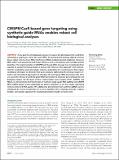CRISPR/Cas9-based gene targeting using synthetic guide RNAs enables robust cell biological analyses
Author(s)
Su, Kuan-Chung; Tsang, Mary-Jane; Emans, Neil; Cheeseman, Iain M
DownloadPublished version (2.292Mb)
Terms of use
Metadata
Show full item recordAbstract
A key goal for cell biological analyses is to assess the phenotypes that result from eliminating a target gene. Since the early 1990s, the predominant strategy utilized in human tissue culture cells has been RNA interference (RNAi)-mediated protein depletion. However, RNAi suffers well-documented off-target effects as well as incomplete and reversible protein depletion. The implementation of CRISPR/Cas9-based DNA cleavage has revolutionized the capacity to conduct functional studies in human cells. However, this approach is still underutilized for conducting visual phenotypic analyses, particularly for essential genes that require conditional strategies to eliminate their gene products. Optimizing this strategy requires effective and streamlined approaches to introduce the Cas9 guide RNA into target cells. Here we assess the efficacy of synthetic guide RNA transfection to eliminate gene products for cell biological studies. On the basis of three representative gene targets (KIF11, CENPN, and RELA), we demonstrate that transfection of synthetic single guide RNA (sgRNA) and CRISPR RNA (crRNA) guides works comparably for protein depletion as cell lines stably expressing lentiviral-delivered RNA guides. We additionally demonstrate that synthetic sgRNAs can be introduced by reverse transfection on an array. Together, these strategies provide a robust, flexible, and scalable approach for conducting functional studies in human cells.
Date issued
2018-10Department
Massachusetts Institute of Technology. Department of BiologyJournal
Molecular Biology of the Cell
Publisher
American Society for Cell Biology (ASCB)
Citation
Su, Kuan-Chung et al. "CRISPR/Cas9-based gene targeting using synthetic guide RNAs enables robust cell biological analyses." Molecular Biology of the Cell 29, 20 (October 2018): 2359-2507 © 2018 The American Society for Cell Biology
Version: Final published version
ISSN
1059-1524
1939-4586